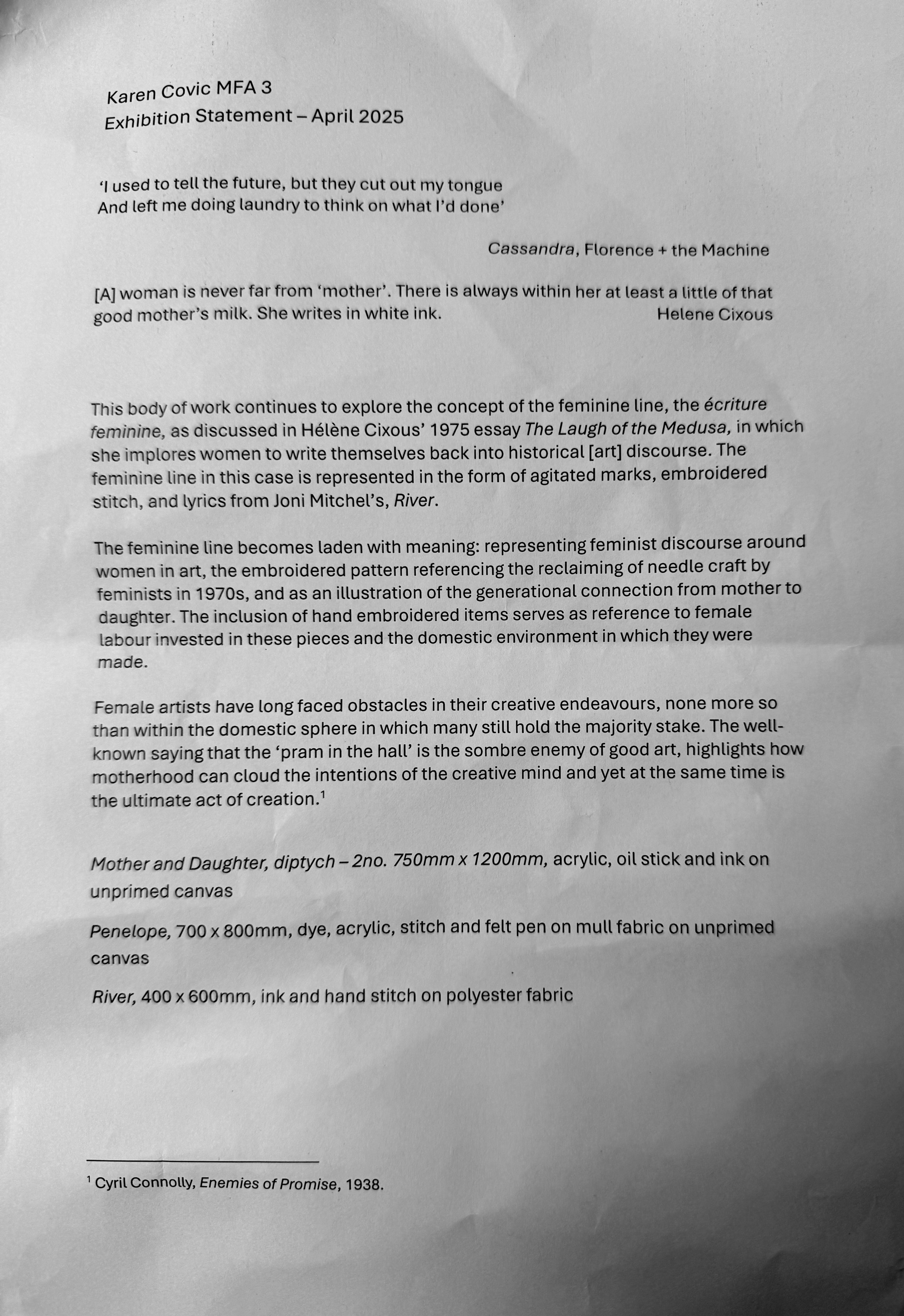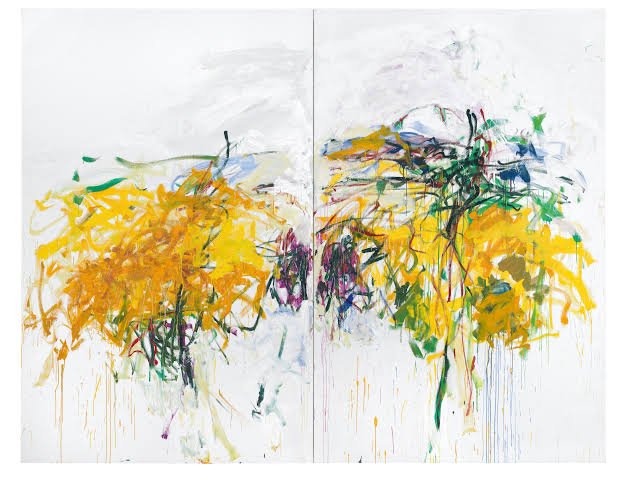April/Autumn Seminar 2025
Crit no. 1 at DEMO
I gave a brief introduction to the group. My interest in the feminine line, investigating embroidery, fabric and stitching into the fabric itself. Last year concerned with tapestry but this year been exploring other forms of the ‘feminine line’. However, I spoke of the fact that I was also feeling a little hemmed in by my domestic duties and motherhood. I was browsing through some works by Joan Mitchell when I saw her Untitled, 1992. It showed a diptych with typically loose, expressive mark making. I thought of asking my 12yr old daughter to therefore paint one canvas and me the other as a collaborative approach. There was an interesting discussion around the different approaches to mark making by us both. The group were under the impression that my daughter had no inhibitions, that there was a rawness in her marks, as she was still without art training. However, as explained later in the second crit, the opposite was true. My daughter was inhibited by the sudden invitation to co-create. She was eager to do well, to please me so she was not free in her movements but a little daunted. She is also of the school age where they are taught how to draw things and therefore have lost the spontaneity of early art making. Also, although I gave her freedoms, I set up the paints to use, my work hung alongside and I had final authorship with the stitching I did across the two panels and some extra lines to connect. The group discussed how the knowledge that my daughter collaborated on one of the diptych, brought different readings into the work. The panels were moved physically closer so that they butted together, as advised by the group, and this seemed to work better with the connecting threads. Not so literal. And I hung the works butted up against one another on the second crit.
The work Carte Blanche, (below), was hung with the Mother and Daughter, in the first crit. The work was a nod to the labour involved in hand embroidery and the white washing was in reference to how women’s work. The group felt that although this was an interesting textural surface, it was less inviting to the viewer and it didn’t really relate to the other work. The World’s Wife diptych, which were shown in the first crit were withdrawn by me as I didn’t feel they worked with the other works. We did discuss the use of text in the works. I was keen to use some of the lines from Carol Ann Duffy’s book of poems, The World’s Wife, but we discussed that maybe these could be used in the titles instead.
Crit no. 2 on Campus (with Anoushka Akel and Dan Arps)
In this crit, I removed three of the works shown at DEMO and introduced the work ‘Penelope’ that was done at the end of last year but not shown because I actually want to move forward with it. The ‘Mother and Daughter’ work was shown butting up to each other as discussed/recommened in the first crit. This proved to be more successful. I also showed a work entitled River, (with lyrics from Joni Mitchell’s song embroidered onto the fabric), again as I wanted to get the group response to working on stretched fabric and using the embroidery hoop to stitch and dye, however we did not have time to discuss this.
Cold reading: tactile, the use of gesture with thread and paint. Usually embroidery is a precise practice. Thread is quite controlled, paint is quite loose. Materials in each work are quite different. Unprimed canvas, medical gauze fabric, on Penelope. Two of the works relate with colour. Although quite different.
One reading of Penelope was repair, trauma, stitching as a repair of the skin. An element of healing. Of escape. Is Penelope asleep.
After the cold reading I gave a brief introduction to my thinking behind each work and my intentions. Dan Arps spoke of his work with prams. An exhibition in London called Acts of Creation was mentioned. Hettie Judah.
Reference to Joan Mitchel in the Mother and Daughter work. Which was accurate as Joan Mitchell’s Untitled 1992, was the inspiration. It was pointed out in the discussion that Mitchell did not have children, as didn’t most of the Abstract Expressionist female artists. (Although they were wives). Perhaps they aren’t good role models therefore and I should look for artists who do have children as role models. Anoushka Akel does have children. I explained that I didn’t want to be defined by motherhood but to acknowledge the constraints that it places on my practice, time wise and headspace. I am more interested in control and release. In unravelling the pattern.
RECOMMENDATIONS for next seminar work = concentrate on fewer elements, for example just the line, just embroidery or just the painted line. To unpack each element and look at them separately. Then to layer in a different order, for later seminars. Confidence in doing less. Text in the titles. Enjoy the use of unprimed canvas. Go large.
Joan Mitchell
Untitled, 1992 - acrylic on canvas












